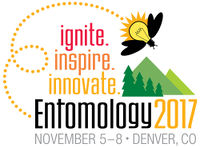Entomology Society of America (ESA) 2017: Difference between revisions
Jump to navigation
Jump to search
No edit summary |
No edit summary |
||
| Line 12: | Line 12: | ||
|- | |- | ||
|} | |} | ||
<br> | |||
<br> | <br> | ||
<br> | <br> | ||
Revision as of 10:27, 29 August 2017
| Quick Links for Big Data and Bugs: How Massively Collected Biodiversity Data Are Changing the Way We Do Insect Science | |
|---|---|
| Date: Tuesday, November 07, 2017,1:30 PM - 5:00 PM | |
| Agenda | |
| Recordings | |
Agenda
| time | talk | presenter / authors |
|---|---|---|
| 1:30 | Welcoming Remarks | |
| 1:35 | Using specimens and linked data in ecological and evolutionary research | Pamela Soltis (psoltis@flmnh.ufl.edu), iDigBio, Gainesville, FL |
| 1:50 | Utilizing digitized specimen data to trace the history and predict the future for an economically important pest of commercial fruits | Crystal Klem (cklem@purdue.edu), Jennifer Zaspel and Alberto Zilli, Purdue University, West Lafayette, IN, The Natural History Museum, London, United Kingdom |
| 2:05 | Ecoinformatics and the curious case of katydids on California mandarins | Bodil Cass (bncass@ucdavis.edu), Elizabeth Grafton-Cardwell and Jay Rosenheim, University of California, Davis, CA, University of California, Riverside, CA |
| 2:15 | Collections data and citizen scientists shaping the conservation decision-making process for at-risk butterfly species | Jaret Daniels (jdaniels@flmnh.ufl.edu) and Dean Jue, University of Florida, Gainesville, FL, Florida Natural Areas Inventory, Tallahassee, FL |
| 2:30 | Real time massive online citizen science biodiversity programs: Lessons from butterflies | Kathleen Prudic (klprudic@email.arizona.edu), Kent McFarland, Rebecca Hutchinson, Jeffrey Oliver, Jeremy Kerr, Maxim Larrivée and Elizabeth C. Long, University of Arizona, Tucson, AZ, Vermont Center for Ecostudies, Norwich, VT, Oregon State University, Corvallis, OR, University of Ottawa, Ottawa, ON, Canada, Montreal Insectarium Space for Life, Montreal, QC, Canada, Mohonk Preserve, New Paltz, NY |
| 2:40 | Bringing the dead alive - The value of dead flies | Erica McAlister (e.mcalister@nhm.ac.uk), Natural History Museum, London, United Kingdom |
| 2:55 | From the tropics to the drawer and back: Digitized New World swallowtail butterfly specimens inform diversity patterns | Hannah Owens (howens@flmnh.ufl.edu) and Laura Brenskelle, University of Florida, Gainesville, FL |
| 3:10 | Low-cost genomic architecture as a species delimitation tool using rDNA fingerprints | John Sproul (johnssproul@gmail.com) and David Maddison, Oregon State University, Corvallis, OR |
| 3:10 | Students discover: ANTS - Connecting science and education | Daniela Sorger (dmsorger@ncsu.edu), Paige Derouin, Maggie McKinley, Michelle Hafey and Rob R. Dunn, North Carolina State University, Raleigh, NC, North Carolina Museum of Natural Sciences, Raleigh, NC, Wake Young Men's Leadership Academy, Raleigh, NC, Burgaw Middle School, Burgaw, NC, Penderlea School, Willard, NC |
| 3:10 | Break and Poster Session | |
| 3:25 | From office wallpaper to research product: How digitization of the Field Museum's water beetles yields insights to their historical distributions in North America | Crystal Maier (crystal.maier@gmail.com), Field Museum of Natural History, Chicago, IL |
| 3:40 | Using nano-CT scanning to study novel ultrasound-producing structures across Lepidoptera | David Plotkin (dplotkin@ufl.edu), Jesse R. Barber and Akito Kawahara, University of Florida, Gainesville, FL, Boise State University, Boise, ID |
| 3:55 | Progressing toward Odomatic: Automatic species identification of Odonata from in situ photographs | William Kuhn (will.kuhn@rutgers.edu) and John C. Abbott, National Science Foundation, Knoxville, TN, University of Alabama, Tuscaloosa, AL |
| 4:05 | Querying semantic phenotypes with transcribed specimen data | Matt J. Yoder (diapriid@gmail.com), István Mikó and Andrew Deans, University of Illinois, Champaign, IL, Pennsylvania State University, University Park, PA |
| 4:20 | Uses of the TaxOnline biocollections data network | Luciane Marinoni (lmarinoni@ufpr.br), Universidade Federal do Paraná, Curitiba, Brazil |
| 4:35 | Challenges and trends in really big insect collection datasets | Katja C. Seltmann (seltmann@ccber.ucsb.edu), University of California, Santa Barbara, CA |
| 4:50 | Discussion |
